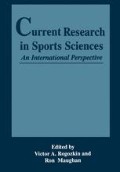Abstract
As reviewed by Vandewalle et al. (Sports Med. 4: 268289, 1987) none of the previous methods has enabled accurate measurement of all the different determinants of maximal anaerobic performance. Consequently, a new maximal anaerobic running power (MARP) test (Rusko et al., Eur. J. Appl. Physiol. 66: 97–101, 1993) was developed. It consisted of n.20s runs on a treadmill with a 100s recovery between the runs. The speed of the treadmill was increased for each consecutive 20s run until exhaustion. The height of counter-movement jumps (CMJ) and blood lactate concentration (bLa) were measured after each run. Based on bLa vs. running power and CMJ vs. running power-curves submaximal and maximal indices of anaerobic running power were calculated and expressed as the oxygen demand of running. The results give information on 1) maximal anaerobic running power, 2) bLa concentration during submaximal sprinting, 3) peak bLa after exhaustion, 4) the height of CMJ, and 5) the decrease in the height of CMJ relative to the running speed and blood lactate concentration. The 400m runners have attained the maximal anaerobic running power of 120 ml kg-1 min-1 (200% of VO2max) in the MARP test. The anaerobic contribution to the energy demand of the last completed 20s sprint is about 70%. Repeatability of the test results has been high.
Access this chapter
Tax calculation will be finalised at checkout
Purchases are for personal use only
Preview
Unable to display preview. Download preview PDF.
References
American College of Sports Medicine: Guidelines for Graded Exercise Testing and Exercise Prescription, 3rd ed. Philadelphia, Lea and Febiger, 1986, p. 168.
Ayalon, A., O. Inbar, and O. Bar-Or. Relationships among measurements of explosive strength and anaerobic power. In: International Series on Sports Sciences, vol 1. Biomechanics IV. Nelson, R.C., and C.A. Morehouse (eds.). Baltimore, University Park Press, 1974, pp. 527–537.
Bar-Or, O. The Wingate anaerobic test: An update on methodology, reliability and validity. Sports Med. 4: 381–394, 1987.
Bosco, C., P. Luhtanen, and P.V. Komi. A simple method for measurement of mechanical power in jumping. Eur. J. Appl. Physiol. 50: 273–282, 1983.
Di Prampero, P.E. Energetics of muscular exercise. Rev. Physiol. Biochem. Pharmacol. 89: 143–222, 1981.
Kindermann, W., G. Simon, and J. Keul. The significance of the aerobic-anaerobic transition for the determination of work load intensifies during endurance training. Eur. J. Appl. Physiol. 42: 25–34, 1979.
Green, H.J., A.E. Patla. Maximal aerobic power: neuromuscular and metabolic considerations. Med. Sci. Sports Exerc. 24: 38–46, 1992.
Margaria, R., P. Aghemo, and E. Rovelli. Measurement of muscular power (anaerobic) in man. J. Appl. Physiol. 21: 1662–1664, 1966.
Noakes, T.D. Implications of exercise testing for prediction of athletic performance: A contemporary perspective. Med. Sci. Sports Exerc.20: 319–330, 1988.
Nummela, A., M. Alberts, R.P. Rijntjes, P. Luhtanen, and H. Rusko. Reliability and validity of the maximal anaerobic running power test. Int. J. Sports Med. 1995. (Accepted for publication)
Nummela, A., A. Mero, and H. Rusko. The effect of sprint training on the anaerobic performance characteristics in the MARP-test. Med. Sci. Sports Exerc. 26: S636, 1994.
Nummela, A., T. Vuorimaa, and H. Rusko. Changes in force production, blood lactate and EMG activity in the 400 m sprint. J. Sports Sci. 10: 217–228, 1992.
Paavolainen, L., K. Hdkkinen, A. Nummela, and H. Rusko. Neuromuscular characteristics and fatigue in endurance and sprint athletes during a new anaerobic power test. Eur. J. Appl. Physiol. 69: 119–126, 1994.
Rusko, H., A. Nummela, and A. Mero. A new method for the evaluation of anaerobic running power in athletes. Eur. J. Appi. Physiol. 66: 97–101, 1993.
Schnabel, A., and W. Kindermann. Assessment of anaerobic capacity in runners. Eur. J. Appl. Physiol. 52: 42–46, 1983.
Szögy, A., and G. Cherebetiu. Minutentest auf dem Fahrradergometer zur Bestimmung der anaeroben Kapazitat. Eur. J. Appl. Physiol. 33: 171–176, 1974.
Thomson, J.M., and K.J. Garvie. A laboratory method for determination of anaerobic expenditure during sprinting. Can. J. Sports Sci. 6: 21–26, 1981.
Tossavainen, M., A. Nummela, L. Paavolainen, A. Mero, and H.K. Rusko. New maximal anaerobic pedalling power test. Med. Sci. Sports Exerc. 26: S852, 1994.
Vandewalle, H., G. Pérès, and H. Monod. Standard anaerobic exercise tests. Sports Med. 4: 268–289, 1987.
Vuorimaa, T., K. Häkkinen, P. Vähäsäyrinki, and H. Rusko. Comparison of three tests measuring maximal running power in sprinters, middle distance runners and marathon runners. In Book of Abstracts, II IOC World Congress on Sport Sciences. 1991 COOB’92, S.A., Barcelona, 1991, p. 257.
Author information
Authors and Affiliations
Editor information
Editors and Affiliations
Rights and permissions
Copyright information
© 1996 Springer Science+Business Media New York
About this chapter
Cite this chapter
Rusko, H.K. (1996). Measurement of Anaerobic Performance Characteristics of Athletes. In: Rogozkin, V.A., Maughan, R. (eds) Current Research in Sports Sciences. Springer, Boston, MA. https://doi.org/10.1007/978-1-4757-2510-0_33
Download citation
DOI: https://doi.org/10.1007/978-1-4757-2510-0_33
Publisher Name: Springer, Boston, MA
Print ISBN: 978-1-4419-3255-6
Online ISBN: 978-1-4757-2510-0
eBook Packages: Springer Book Archive

